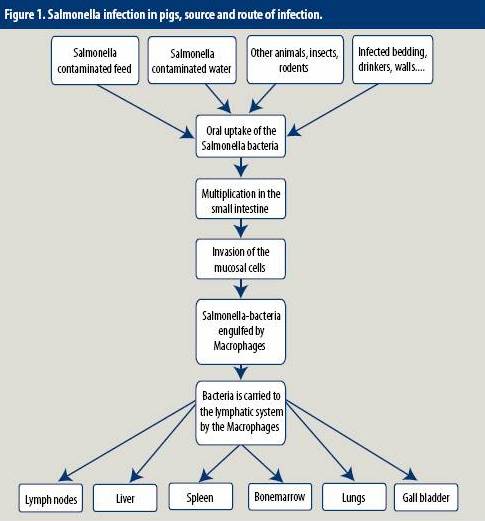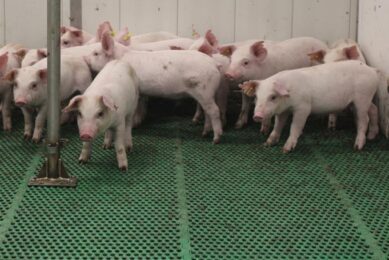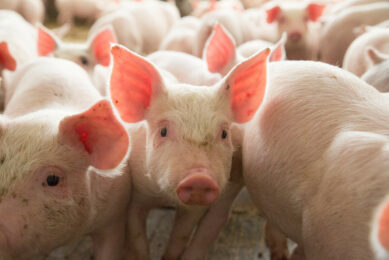Nutritional approaches to controlling Salmonella

The ability of Salmonella to survive in a variety of environments for prolonged periods of time makes eradication of this bacterium very difficult once it has entered the farm. Therefore, only integrated management strategies that take into account many factors can result in a reduction of Salmonella at farm level.
By Dr Colm A. Moran, Alltech European Bioscience Centre, Dunboyne, Ireland
Salmonella is generally accepted to be one of the most important zoonoses transmitted by meat and eggs in the developed world. Whilst the majority of salmonellosis infections arise from consumption of poultry products, the pork industry is not blameless. In Europe, during 2006, a total of 5,355 food-borne outbreaks were reported with 53% being caused by Salmonella (EFSA, 2007).
However, the numbers are much larger when one looks at the total confirmed individual cases of 151,995 reported from the 27 EU member states. Weekly media reports on salmonellosis epidemics have raised the awareness of the consumer to the point where legislation is being imposed by governments to control Salmonella. There is little doubt that surveillance programmes that timely detect Salmonella contaminations in the entire food chain (animal feed, living animals, slaughterhouses, retail sector and restaurants) together with sanitary measures are essential to detect and prevent human Salmonella infections. New EU legislation will enforce control through financial penalties on producers with high levels of Salmonella when monitored on entry to the slaughterhouse.
Salmonellosis is caused by a gram-negative, facultative anaerobic intracellular bacteria. There are more than 2,500 serotypes of Salmonella that can be found in the intestinal tract of animals, birds and humans. The epidemiology of Salmonella is complex and can come from a variety of sources and causes severe disruption on a farm (Figure 1). However, in order to survive in the intestine, as well as to multiply and invade intestinal cells, Salmonella needs to attach to receptors on the intestinal wall.
Salmonella adherence to host tissue is regarded as an important initial step for colonisation and pathogenesis. The majority of Salmonella colonise the gastro-intestinal tract using specialised structures known as Type-1 fimbriae. These receptors have specificity for mannose, a sugar that is found on the surface of epithelial cells in the intestine.
Integrated approach
Traditionally the industry has been lax in its control of Salmonella often relying on the end consumer to cook the product properly to eliminate the pathogen. Oftentimes the industry used in-feed antibiotics to control Salmonella where a known herd had high shedding rates of the bacteria. The EU has now banned the practice of including AGPs, both for growth promotion and for the reduction of Salmonella on farm due to increased social pressure from governmental bodies and consumers.
Many strategies for reduction of Salmonella shedding in the past have been tried and tested, often with unsatisfactory results, like for example, vaccines in pig operations. No Salmonella control strategy has been successful on its own. Therefore, the control of Salmonella must be considered in terms of an integrated approach combining specific nutritional technology with improved hygiene, biosecurity, and management practices, which when carried out in unison will help to reduce levels of Salmonella on the farm. One area that has gained significant attention in recent years is that of nutritional additives to reduce Salmonella colonisation and/or Salmonella survival.
Nutritional strategies
The inclusion of feed additives for the control of Salmonella has been somewhat empirical and oftentimes the concentrations used in commercial operations is determined by cost of addition rather than the scientifically determined minimum inhibitory concentration as determined by the supplier or original scientific group. This has caused many in the pig industry to be wary of new products on the market. Clearly the product must stand up to peer review and have the necessary in vivo data to support the products claims. To date only a limited number of products have gained commercial acceptance, including:
• Short chain fatty acids – including formic, propionic, butyric acids
• Medium chain fatty acids – caproic, caprylic, capric acids
• Essential oils
• Probiotics – Lactobacillus sp., Lactococcus sp., Bifidobacteria sp., Pediococcus sp., Enterococcus sp., Saccharomyces sp.
• Anti-infective glycans – oligomers or polymers of mannose
The basis for anti-infective agents
Carbohydrates (glycans) have long been known to be an important dietary component, seen predominantly as energy-yielding molecules and structural components of plant materials. Recently, studies have demonstrated that non-digestible carbohydrates play an important role in animal production and human health. Moreover, there is a growing recognition that non-digestible carbohydrates play a vital role in cellular metabolism, protein structure and function, cell-to-cell communication, host immunity and anti-adhesion therapy.
Mechanisms of bacterial pathogenesis have become a progressively more important subject as pathogens have become increasingly resistant to current antibiotics. Adhesion of pathogens to the epithelium surface of the gut (colonisation) is the first critical stage leading to infection. It is mediated by lectins (carbohydrate binding proteins) present on the surface of the infectious bacteria that bind to complementary carbohydrates on the surface of the host gastro-intestinal tissue. The ability to block bacterial adhesion represents an ideal strategy to combat bacterial pathogenesis because of its importance early in the infectious process, and it’s also suitable for implementation as a prophylactic strategy to prevent infection.
In the case of the majority of Salmonella, mannose-specific lectins (Type-1 fimbriae) on the bacterial surface recognise glycoproteins (rich in mannose) on the intestinal surface. For that reason, many producers are including materials rich in mannose to their diets as the Salmonella binds to mannose instead of the gut wall (Figure 2). The Salmonella are then literally flushed out of the intestine attached to the mannose rich material. This is known colloquially as the ‘Oligosaccharide Decoy Mechanism’.
Mannanoligosaccharides (MOS) are more effective than free mannose in their ability to bind to Salmonella. In 2008, researchers at Wageningen Agricultural University, Becker and Galletti, published a comprehensive study of food and feed components for their adhesive properties to Salmonella; finding that products rich in yeast mannanoligosaccharides represented the most efficient binding matrix.
Studies in pigs and poultry
Alltech have pioneered industrial extraction procedures that are currently used to produce functional mannanoligosaccharide extracts from Saccharomyces cerevisiae cell wall and market this product under the Bio-Mos® brand name. The early work of Dr Peter Spring (Swiss Agricultural College) led to the large scale use of mannanoligosaccharides within the poultry industry for the control of Salmonella. He demonstrated that mannanoligosaccharides could significantly reduce the colonisation of Salmonella Typhimurium in the cecae of chicks, even under large challenge conditions.
The swine industry is also discovering the value of mannanoligosaccharides as there are many producers within the EU using mannanoligosaccharides as part of their integrated Salmonella control strategy and results can be quickly observed using the surveillance practices in place, through meat juice ELISA titres.
In a Danish study in 2007, the inclusion of 1 kg/T mannanoligosaccharides in finisher diets on a commercial pig unit reduced the number of positive meat juice samples from 23.8 % at the end of September to 2.8% at the end of December. In a pilot study on a UK pig farm where a strict cleaning and hygiene programme had in the past failed to reduce the percentage of Salmonella positive meat juice samples at slaughter, the inclusion of mannanoligosaccharides in diets at 1 kg/T was successful. The meat juice ELISA scores were reduced from 28% positive to <5% over a six-month period which in turn categorised the farm as Level 1 under the UK ZAP (Zoonoses Action Plan) scheme.
These studies with the earlier mentioned product demonstrate that a functional carbohydrate can play an integral role in the reduction and maintenance of low Salmonella scores in pigs.
References upon request.
Find more on the new Salmonella guidelines in Pig Progress 24.09, ‘New standards for Salmonella’.











